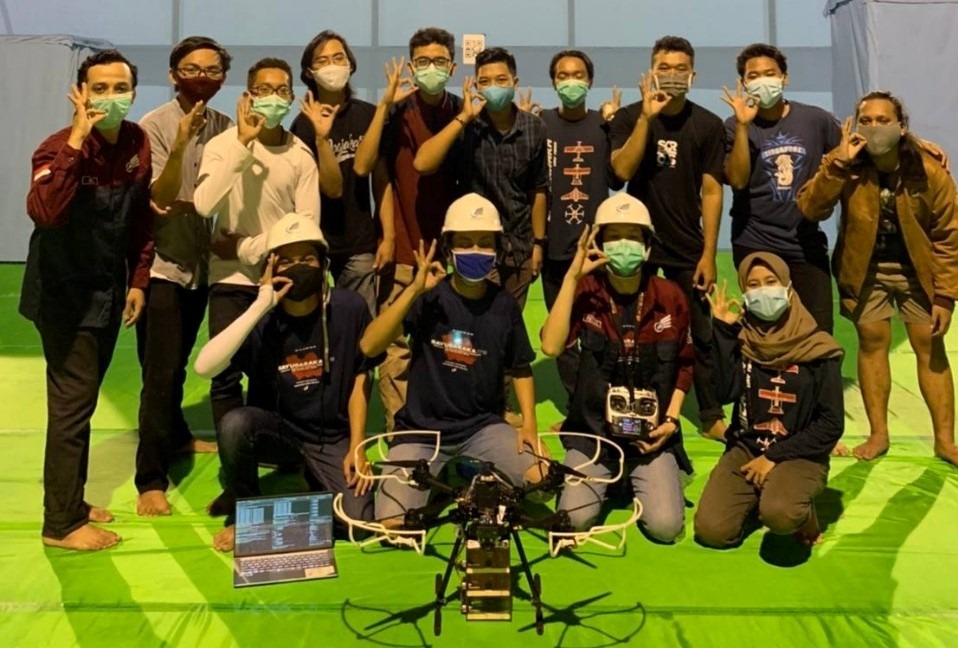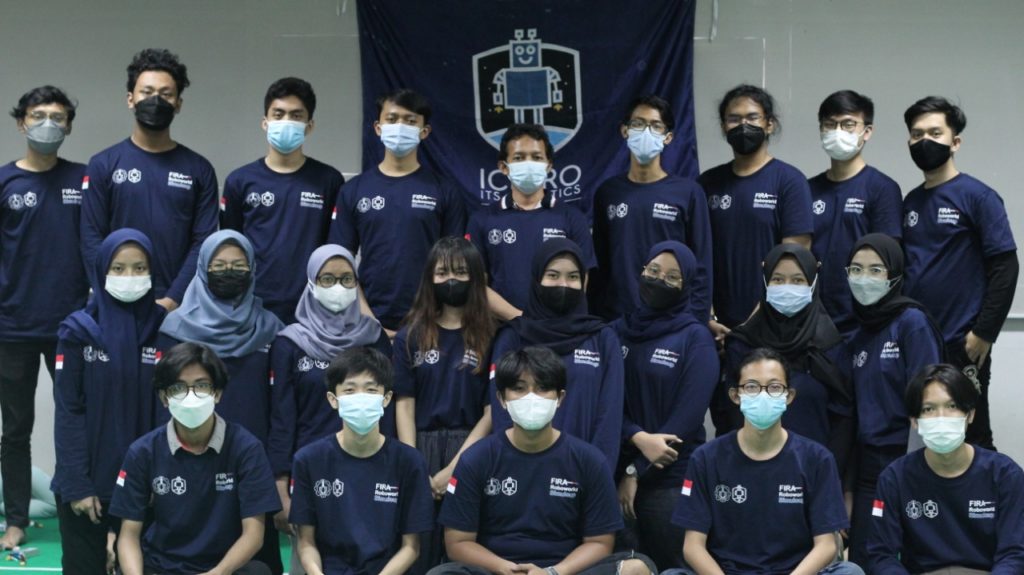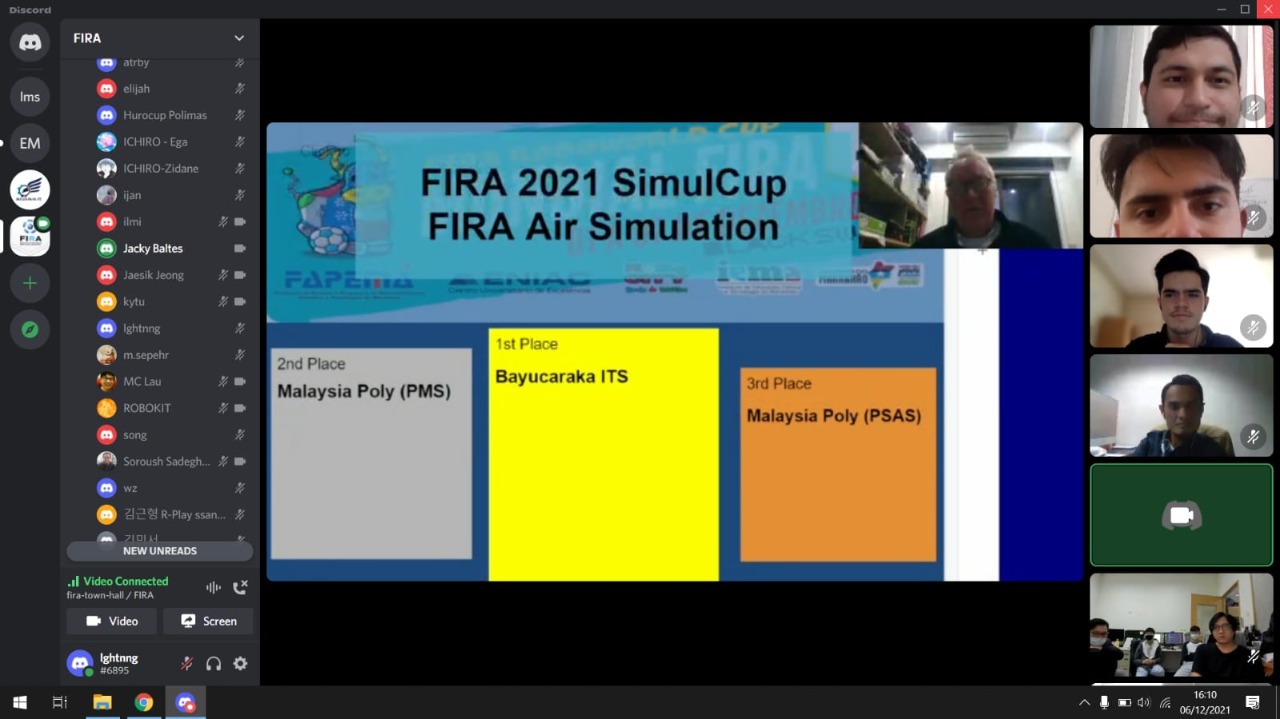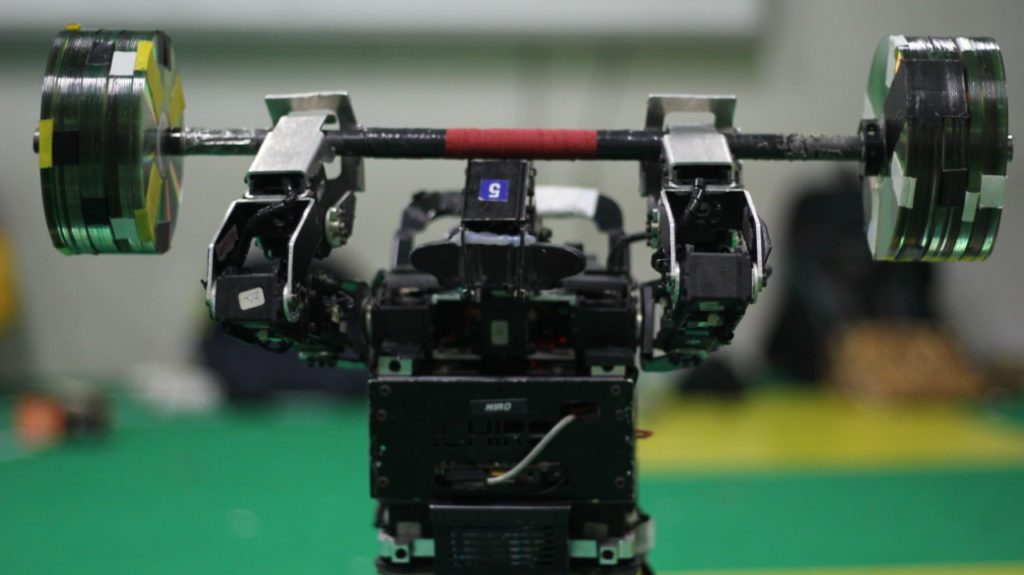ITS Wins 10 Awards at International Robotics Competition

The ITS Bayucaraka team won the Air Simulation Cup champion at the FIRA SimulCup 2021
ITS Campus, ITS News – Institut Teknologi Sepuluh Nopember (ITS) continues to show its prowess in the robotics field globally. This time, the ITS Robotics team which sent the flying robot Bayucaraka and humanoid robot Ichiro managed to win 10 awards in the FIRA SimulCup 2021 hosted online from Brazil, last Tuesday (7/12).
ITS Robotics Team supervisor representative Atar F Babgei ST MSc explained that Fira SimulCup is an adaptation to the Covid-19 pandemic from the prestigious international robotics competition, FIRA RoboWorld Cup, which was last held in 2019. they transformed it into a simultaneous competition held simultaneously from various locations around the world from each participating country and home bases in Brazil, South Korea, and Taiwan. “Reflecting on current conditions, we chose to compete online from campus,” explained Atar.

The ITS Ichiro team which won 10 titles at the FIRA SimulCup 2021 in the HuroCup field
This competition, added Atar, is presented for the category of a student (pro) and student (youth) levels. In this case, the ITS Robotics Team sent the Bayucaraka Team for the Vertical Take-Off and Landing (VTOL) division which competed in the Air Simulation Competition – Pro field. Also, three of Team Ichiro’s robots for the HuroCup – Pro field. “The Ichiro team itself competes in the Sprint, Basketball, Weight-lifting, and Archery competitions with one big robot (adult size) and two small robots (kid size),” said the lecturer, who is also the supervisor of the Bayucaraka team.
With the short preparation time after competing in the national competition, the Bayucaraka Team managed to win first place. In the field of Air Simulation Competition, according to Atar, participants are challenged to set up a virtual flying robot simulation programming that can pass through a moving obstacle in the form of a moving gate. “This simulation is repeated three times; then the results are recorded,” he explained.
Compared to its competitors, according to Atar, the Bayucaraka Team’s simulation was 100 percent successful in getting through the gate with the fastest time so that it won the championship title. The team recognizes this type of competition model as providing its challenges because it does not use a physical form but simulations during training. “The difficulty is, certain specifications from the committee limit us, so many are not by our previous research,” said Atar.

The ITS Bayucaraka team was declared the first winner in the Air Simulation category at the FIRA SimulCup 2021
Meanwhile, Team Ichiro managed to win nine awards in the HuroCup field. In the Sprint competition, Ichiro’s team won first place for adult size and kid-size. The competition challenges the robot to run forward and backward as far as three meters for adult-size and four meters for kid-size. “Interestingly, Team Ichiro was able to set a new world record for kid-size robots with a time of 28 seconds and 39 seconds for adult size,” said Atar proudly.
Next, for the Weightlifting competition, the robot made by Team Ichiro won first place for adult size and second place for kid-size. In this competition number, the robot is challenged to lift a maximum load of five times. “The concept is like a weightlifting competition at the Olympics, where the Ichiro team’s robot managed to lift 100 discs for the adult-size category,” explained the lecturer at the ITS Biomedical Engineering Department.
Meanwhile, they challenged the robot to put the ball into the basket in five rounds for the Basketball category. There are three types of points for this race number based on the distance the robot enters the ball, namely five, three, and two points. In this case, Ichiro’s team targets to get only two issues with the most profound location distance. Amazingly, the team under the guidance of Muhtadin ST MT was able to get the first prize for adult size and third for kid-size.
 The robot made by the IchiroITS Team that competes in the weightlifting category at the FIRA SimulCup 2021
The robot made by the IchiroITS Team that competes in the weightlifting category at the FIRA SimulCup 2021
The Ichiro team won second place in the all-around adult and kid-size category. The parameter is the robot that collects the most medals in this category. Atar admitted, there is an option for the team to get first place in this category. However, the team chose to keep the champion in each race event by changing some robot parts. “It’s a different story if there is a football competition number for the fastest robot, there is a possibility that we can get first place,” he said.
Again, Atar revealed that there were still many challenges that the team had to face until it finally won the ten championship titles. As is the case, basketball and archery competition numbers are a new experience for Ichiro’s team. Those categories require repeated trial and error because the robot must be operated automatically. “The robot is the same as the previous competition, but the algorithm is much different because this competition involves all parts of the robot to work,” he said.
Behind all these challenges, it is a very brilliant achievement from the ITS Robotics Team to beat foreign competitors such as Russia, South Korea, Taiwan, Iran, Brazil, and Malaysia. Atar sees this competition as a challenge to continue to develop new technologies that are increasingly at the forefront. “So that in the future, ITS robotics research can continue to provide benefits as a solution to problems in society,” he concluded hopefully. (ITS Public Relations)
Reporter: Astri Nawwar Kusumaningtyas
Related News
-
ITS Wins 2024 Project Implementation Award for Commitment to Gender Implementation
ITS Campus, ITS News —Not only technology-oriented, Institut Teknologi Sepuluh Nopember (ITS) also show its commitment to support gender
December 09, 2021 22:12 -
ITS Professor Researched the Role of Human Integration in Sustainable Architecture
ITS Campus, ITS News –The developing era has an impact on many aspects of life, including in the field
December 09, 2021 22:12 -
ITS Sends Off Group for Joint Homecoming to 64 Destination Areas
ITS Campus, ITS News — Approaching Eid al-Fitr, the Sepuluh Nopember Institute of Technology (ITS) is once again facilitating academics who want
December 09, 2021 22:12 -
ITS Expert: IHSG Decline Has Significant Impact on Indonesian Economy
ITS Campus, ITS News — The decline in the Composite Stock Price Index (IHSG) by five percent on March 18,
December 09, 2021 22:12
